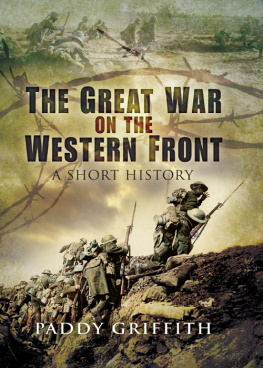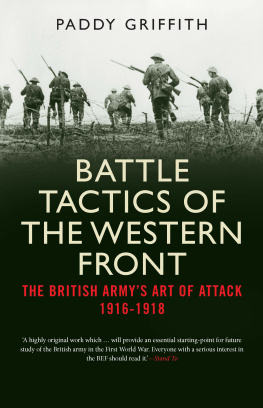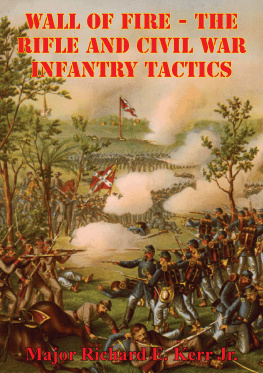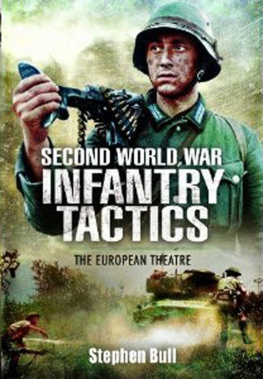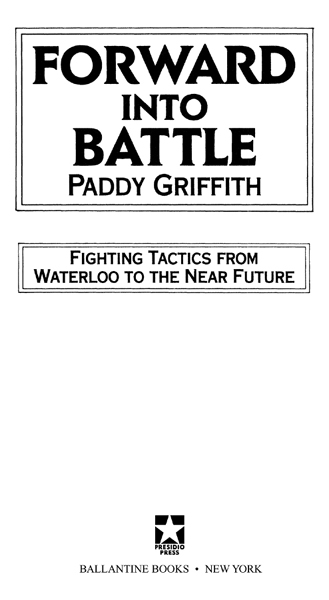The author wishes to make it absolutely clear that responsibility for the ideas and opinions which follow lies not with any of the acknowledged persons, nor with the British Government or Ministry of Defence, but solely, entirely and completely with himself.
A Presidio Press Book
Published by The Random House Ballantine Publishing Group
Copyright 1981, 1990 by Paddy Griffith
First published in 1981 by Anthony Bird Publications Ltd., Chichester, Sussex, England
All rights reserved under International and Pan-American Copyright Conventions. Published in the United States by The Random House Ballantine Publishing Group, a division of Random House, Inc., and simultaneously in Canada by Random House of Canada Limited, Toronto.
Presidio Press is a trademark of Random House, Inc.
www.ballantinebooks.com
Library of Congress Cataloging-in-Publication Data
Griffith, Paddy
Forward into battle : fighting tactics from Waterloo to the near future / Paddy Griffith
p. cm.
This revised and updated edition first published in England in 1990 by the Crowood PressT. p. verso.
Includes bibliographical references.
eISBN: 978-0-307-77950-2
1. TacticsHistory19th century. 2. TacticsHistory20th century. 3. Military history, Modern19th century. 4 Military history, Modern20th century. I. Title.
U165.G69 1992
355.42090dc20 92-4488
Line-diagrams by Sharon Perks ()
v3.1
Dedication
For Genevive and Robert
Contents
Acknowledgements

In the original edition I expressed particular gratitude to Professor Norman Gibbs, and also to Ned Wilmott, Andy Callan, John Ellis, Christopher Duffy, Nigel de Lee, Richard Holmes, David Chandler, John Keegan, Ann Johnson and John Hunt and I wish to repeat and reinforce all that gratitude here.
In the years since 1981 I have been quite overwhelmed by the scale of the additional help and support which I have received from many other quarters. I cannot, alas, mention everyone here, and I am sincerely sorry that this listing is necessarily so uninformative and incomplete. I owe especial thanks to Elmar Dinter, Andy Grainger and Paul Harris for many stimulating discussions on these subjects; but scarcely less important has been the help freely given by the following additional persons (in alphabetical order, and with apologies for omission of titles, degrees, military ranks, and so on): Martin Alexander, Dick Applegate, Jim Arnold, Diana Ashdown, de Witt Bailey, Ian Beckett, Matthew Bennett, Kathy Clarke, Tony Clayton, Peter Cross, Mark Cuthbert-Brown, Peter Dennis, Charles Dick, Chris Donnelly, John Drewienkiewicz, Charles Esdaile, Hugh Faringdon, R.E.M. Foster, Steve Fratt, Michael Glover, Ian Greenwood, Arthur Harman, Paul Heap, Peter Hofschroer, Sidney Jary, Barrie Jones, Chris Kemp, David Kirkpatrick, John Koontz, Jean Lochet, Kenneth Macksey, Peter MacManus, Terry Martin, Greg McCauley, Phil Melling, Ren and Marguerite Mouriaux, Anne Nason, Andrew Orgill, Joe Park, Dan Radakovitch, Gunther Rothenberg, Richard Shirreff, David B. Sweet, Wally Simon, David Swinburne, Freddie Walker, Jeff Walsh, Howard Whitehouse, Patrick Yapp and Ned Zuparko.
I am particularly grateful to the librarians at both Sandhurst and Camberley for their diligence; to the members of and speakers at the Wardig society for their searching weekly analyses; to all my RCC and JCSC students since time began, for their unconscious yet very real inspiration; and to Tony Bird for his all-too-often-tested forbearance.
Paddy Griffith
Owlsmoor, August 1989
Preface

This second edition of Forward into Battle has been significantly expanded and revised since the book first appeared in 1981. The main chapters have been retained almost unchanged, but new sections have been added at the end of each one, and both the introduction and final chapter have been rearranged and expanded. The extra material is intended to update the original findings at the same time as exploring the subject matter in a little more breadth and depth.
Since 1981 I have looked at several additional aspects of the history of modern tactics, and have filled in some of the gaps in my story that were then identified by readers. There are therefore now additional discussions of Napoleonic firepower, of the American Civil War, of the French in August 1914, and of the use of armour both during and after the Second World War. Furthermore, the story no longer stops at 1973, but has been extended into the near future.
When it was originally published in 1981, Forward Into Battle tried to break new ground in a number of different directions. It challenged, for example, the generally accepted view that Wellingtons infantry had won its victories by firepower from a static line. It revealed that the empty battlefield was not quite the early twentieth-century innovation that had often been assumed, but had earlier precedents, and it questioned the popularly held stereotype that the tank dominated the battlefield between 1916 and 1945. It also opened up an unconventional perspective on the helicopter revolution that has often been claimed for the American mainforce effort in Vietnam.
The book was greeted with enthusiasm and great interest by some, but with a certain incredulity by many others. The idea that technology and hardware were not the be-all and end-all of combat seemed at that time to be such a radical and strange perspective that many people were tempted to dismiss the book out of hand. Veterans of Vietnam who had seen other aspects of that war came close to denying the reality of the firefights in the Central Highlands reported by S. L. A. Marshall. Tankies defended the reality of the allegedly all-conquering, all-tank Blitzkrieg. First World War buffs blustered their denial of Rommels 1914 experience of innocuous shelling, and Wellingtonians wilfully claimed that Griffith believes bullets do not kill people in battle.
It is, of course, gratifying for any author to attract such a sparkling spectrum of criticism, since all publicity is good publicity. However, it is also frustrating to find that ones long-considered and documented findings, on such a wide spread of subjects, can apparently be dismissed so lightly and easily. Almost immediately following their publication, however, the general ideas expressed in Forward Into Battle chanced to be tested against the reality of a new infantry war this time one fought for possession of the Falkland Islands in the South Atlantic Ocean.
I certainly experienced a measure of the tragedy and irony of the 1982 events, since a number of my former students and friends were direct participants, and others were significant helpers. I was moved by the vivid picture of modern warfare which the survivors painted but I also found grounds for believing that my own earlier unfashionable propositions had been quite vividly, pungently and appropriately vindicated. Whatever else it was, the Falklands War was surely a triumph of morale, training and cold steel over numbers, hardware and bombs.




